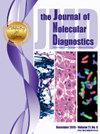Diagnosis of Australasian Patients with Neuromuscular Disease
IF 3.4
3区 医学
Q1 PATHOLOGY
引用次数: 0
Abstract
Neurogenetic disorders are a large group of genetic and phenotypically heterogeneous diseases, making diagnosis challenging. Sequencing hundreds of disease genes concurrently using massively parallel sequencing is, therefore, invaluable for diagnosis of these disorders. The PathWest neuromuscular disease gene panels include all known genes associated with neurologic and muscle disorders. Initially implemented in 2013, covering 336 genes, the gene panel has undergone various updates in chemistries and seen the addition of many newly described neurogenic disease genes. The results from versions 3 and 5 of the panel are reported, which included 644 and 830 genes, respectively. In total, 3961 patients were tested across 20 phenotypic subpanels: 2740 on version 3 and 1221 on version 5. Overall diagnostic success was 23.0%, with 8.4% of diagnoses attributed to newly added genes. Diagnostic success varied greatly between phenotypic subpanels, from 63.4% for the congenital muscular dystrophy subpanel to 2.6% for the Alzheimer disease/frontotemporal dementia subpanel. The five most frequently reported genes, DMD, RYR1, SPG7, PMP22, and NOTCH3, accounted for 22% of all diagnoses. Changing chemistries improved coverage of regions that were previously not well resolved. This enabled improved copy number variant calling, with 10.5% of diagnoses from version 5 attributed to copy number variants. The data generated have enabled identification of factors broadly affecting diagnosis of neuromuscular disorders and potential limitations hampering diagnostic success.
澳大利亚神经肌肉疾病患者的诊断
神经遗传疾病是一大群遗传和表型异质性疾病,使诊断具有挑战性。因此,使用大规模平行测序同时对数百种疾病基因进行测序,对于这些疾病的诊断是非常宝贵的。PathWest神经肌肉疾病基因面板包括所有已知的与神经和肌肉疾病相关的基因。该基因面板最初于2013年实施,涵盖336个基因,经历了化学方面的各种更新,并增加了许多新描述的神经源性疾病基因。报告了第三版和第五版的结果,分别包括644个和830个基因。总共有3961名患者在20个表型亚组中进行了测试:版本3为2740名,版本5为1221名。总体诊断成功率为23.0%,其中8.4%的诊断归因于新添加的基因。诊断成功率在表型亚组之间差异很大,从先天性肌肉萎缩症亚组的63.4%到阿尔茨海默病/额颞叶痴呆亚组的2.6%。五种最常报道的基因,DMD, RYR1, SPG7, PMP22和NOTCH3,占所有诊断的22%。不断变化的化学物质提高了以前没有得到很好解决的地区的覆盖率。这使得改进的拷贝数变体调用得以实现,版本5中10.5%的诊断归因于拷贝数变体。所产生的数据已经能够识别广泛影响神经肌肉疾病诊断的因素和阻碍诊断成功的潜在限制。
本文章由计算机程序翻译,如有差异,请以英文原文为准。
求助全文
约1分钟内获得全文
求助全文
来源期刊
CiteScore
8.10
自引率
2.40%
发文量
143
审稿时长
43 days
期刊介绍:
The Journal of Molecular Diagnostics, the official publication of the Association for Molecular Pathology (AMP), co-owned by the American Society for Investigative Pathology (ASIP), seeks to publish high quality original papers on scientific advances in the translation and validation of molecular discoveries in medicine into the clinical diagnostic setting, and the description and application of technological advances in the field of molecular diagnostic medicine. The editors welcome for review articles that contain: novel discoveries or clinicopathologic correlations including studies in oncology, infectious diseases, inherited diseases, predisposition to disease, clinical informatics, or the description of polymorphisms linked to disease states or normal variations; the application of diagnostic methodologies in clinical trials; or the development of new or improved molecular methods which may be applied to diagnosis or monitoring of disease or disease predisposition.

 求助内容:
求助内容: 应助结果提醒方式:
应助结果提醒方式:


